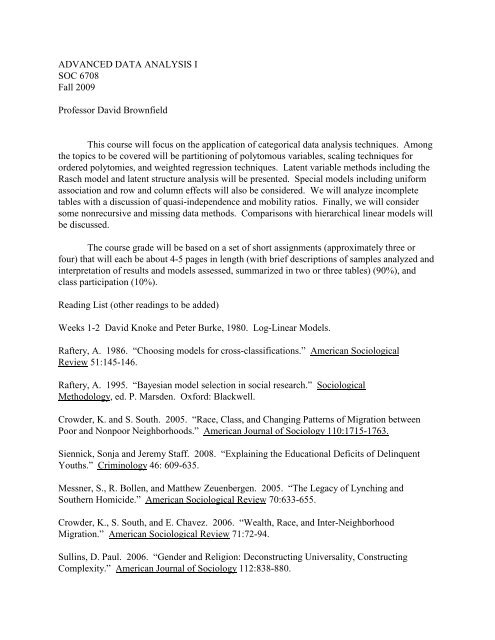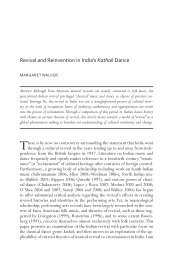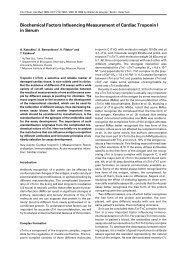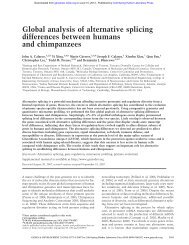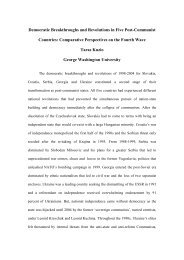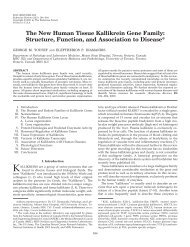ADVANCED DATA ANALYSIS I - University of Toronto
ADVANCED DATA ANALYSIS I - University of Toronto
ADVANCED DATA ANALYSIS I - University of Toronto
You also want an ePaper? Increase the reach of your titles
YUMPU automatically turns print PDFs into web optimized ePapers that Google loves.
<strong>ADVANCED</strong> <strong>DATA</strong> <strong>ANALYSIS</strong> I<br />
SOC 6708<br />
Fall 2009<br />
Pr<strong>of</strong>essor David Brownfield<br />
This course will focus on the application <strong>of</strong> categorical data analysis techniques. Among<br />
the topics to be covered will be partitioning <strong>of</strong> polytomous variables, scaling techniques for<br />
ordered polytomies, and weighted regression techniques. Latent variable methods including the<br />
Rasch model and latent structure analysis will be presented. Special models including uniform<br />
association and row and column effects will also be considered. We will analyze incomplete<br />
tables with a discussion <strong>of</strong> quasi-independence and mobility ratios. Finally, we will consider<br />
some nonrecursive and missing data methods. Comparisons with hierarchical linear models will<br />
be discussed.<br />
The course grade will be based on a set <strong>of</strong> short assignments (approximately three or<br />
four) that will each be about 4-5 pages in length (with brief descriptions <strong>of</strong> samples analyzed and<br />
interpretation <strong>of</strong> results and models assessed, summarized in two or three tables) (90%), and<br />
class participation (10%).<br />
Reading List (other readings to be added)<br />
Weeks 1-2 David Knoke and Peter Burke, 1980. Log-Linear Models.<br />
Raftery, A. 1986. “Choosing models for cross-classifications.” American Sociological<br />
Review 51:145-146.<br />
Raftery, A. 1995. “Bayesian model selection in social research.” Sociological<br />
Methodology, ed. P. Marsden. Oxford: Blackwell.<br />
Crowder, K. and S. South. 2005. “Race, Class, and Changing Patterns <strong>of</strong> Migration between<br />
Poor and Nonpoor Neighborhoods.” American Journal <strong>of</strong> Sociology 110:1715-1763.<br />
Siennick, Sonja and Jeremy Staff. 2008. “Explaining the Educational Deficits <strong>of</strong> Delinquent<br />
Youths.” Criminology 46: 609-635.<br />
Messner, S., R. Bollen, and Matthew Zeuenbergen. 2005. “The Legacy <strong>of</strong> Lynching and<br />
Southern Homicide.” American Sociological Review 70:633-655.<br />
Crowder, K., S. South, and E. Chavez. 2006. “Wealth, Race, and Inter-Neighborhood<br />
Migration.” American Sociological Review 71:72-94.<br />
Sullins, D. Paul. 2006. “Gender and Religion: Deconstructing Universality, Constructing<br />
Complexity.” American Journal <strong>of</strong> Sociology 112:838-880.
Week 3:<br />
Duncan, O.D. 1975. “Partitioning polytomous variables in multiway contingency<br />
analysis.” Social Science Research 4:167-182.<br />
Duncan, O.D. and J. McRae, Jr. 1978. “Multiway contingency analysis with a scaled response<br />
or factor.” Sociological Methodology, ed. K. Schuessler. San Francisco: Jossey-Bass.<br />
Gerber, Theodore. 2006. “Getting Paid: Wage Arrears and Stratification in Russia.”<br />
American Journal <strong>of</strong> Sociology 111:1816-1870.<br />
Xie, Min and David McDowall. 2008. “Escaping Crime: The Effects <strong>of</strong> Direct and Indirect<br />
Victimization on Moving.” Criminology 46:809-840.<br />
Week 4:<br />
Gerber, Theodore and Michael Hout. 2004. “Tightening Up: Declining Class Mobility during<br />
Russia’s Market Transition.” American Sociological Review 69:677-694.<br />
Faust, K. And S. Wasserman. 1993. “Correlation and association models for studying<br />
measurements on ordinal relations.” Sociological Methodology, ed. P. Marsden. Oxford:<br />
Blackwell.<br />
Goodman, L. 1979. “Simple models for the analysis <strong>of</strong> association in cross-classifications<br />
having ordered categories.” Journal <strong>of</strong> the American Statistical Association 74:537-552.<br />
Duncan, O.D. 1979. “How destination depends on origin in the mobility table.” American<br />
Journal <strong>of</strong> Sociology 84:793-804.<br />
Hout, M. 1982. “Using uniform association models.” Pp. 115-128 in J. Hagan, ed.,<br />
Quantitative Criminology. Beverly Hills: Sage.<br />
Goodman, L. 1969. “How to ransack mobility tables and other cross-classifications<br />
having ordered rows and columns.” American Journal <strong>of</strong> Sociology 75:1-35.<br />
Hauser, R. 1987. “Reply to Kim.” Social Forces 65: 806-815.<br />
Weeks 5-6:<br />
Vermunt, Jeroen. 2003. “Multilevel Latent Class Models.” Sociological Methodology, ed.<br />
Ross Stolzenberg. New York: ASA.<br />
Yamaguchi, K. 2000. “Multinomial logit latent-class regression models.” American Journal<br />
<strong>of</strong> Sociology 105:1702-1740.<br />
Anderson, C. and J. Vermunt. 2000. “Log-Multiplicative association models as latent<br />
variable models for nominal and/or ordinal data.” Sociological Methodology, ed. M. Becker<br />
and M. Sobel. Oxford: Blackwell.
Wright, E.O. and D. Cho. 1992. “The relative permeability <strong>of</strong> class boundaries to<br />
cross-class friendships.” American Sociological Review 57:85-102.<br />
Western, M. and E.O. Wright. 1994. “The permeability <strong>of</strong> class boundaries to<br />
intergenerational mobility among men in the United States, Canada, Norway, and<br />
Sweden.” American Sociological Review 59:606-629.<br />
Roncek, D. 1991. “Using logit coefficients to obtain the effects <strong>of</strong> independent<br />
variables on changes in probabilities.” Social Forces 70:509-518.<br />
DeMaris, A. 1993. “Odds versus probabilities in logit equations.” Social Forces<br />
057-1065.<br />
Nagin, D. and G Pogarsky. 2003. “An experimental investigation <strong>of</strong> deterrence.”<br />
Criminology 41:167-194.<br />
Allison, P. 2001. “Multiple imputation for missing data.” Sociological Methods and<br />
Research 28:301-309.<br />
Messner, S., G. Deane, and M. Beaulieu. 2002. “A Log-multiplicative association model<br />
For allocating homicides with unknown victim-<strong>of</strong>fender relationships.”<br />
Criminology 40:457-480.<br />
Week 7:<br />
Clogg, C. 1982. “Using association models in sociological research.” American Journal <strong>of</strong><br />
Sociology 88:114-134.<br />
Weeks 8-10<br />
Clogg, C. and L. Goodman. 1985. “Simultaneous latent structure analysis in several groups.”<br />
Sociological Methodology, ed. N. Tuma. San Francisco: Jossey-Bass.<br />
Clogg, C. and L. Goodman. 1986. “On scaling models applied to data from several groups.”<br />
Psychometrika 51:123-135.<br />
Goodman, Leo. 2007. “On the Assignment <strong>of</strong> Individuals to Latent Classes.”<br />
Sociological Methodology, ed.Yu Xie. New York: ASA.<br />
Brownfield, D. and A. Sorenson. 1987. “A latent structure analysis <strong>of</strong> delinquency.”<br />
Journal <strong>of</strong> Quantitative Criminology 3:103-124.<br />
Sorenson, A. and D. Brownfield. 1989. “Patterns <strong>of</strong> adolescent drug use: inferences<br />
from latent structure analysis.” Social Science Research 18:271-290.
Birkelund, G., L. Goodman, and D. Rose. 1996. “The latent structure <strong>of</strong> job characteristics<br />
<strong>of</strong> men and women.” American Journal <strong>of</strong> Sociology 102:80-113.<br />
McCutcheon, A. 1996. “Multiple group association models with latent variables: An<br />
analysis <strong>of</strong> secular trends in abortion attitudes, 1972-1988.” Sociological Methodology,<br />
ed. A. Raftery. Oxford: Blackwell.<br />
Reiser, M. 1989. “An application <strong>of</strong> the item-response model to psychiatric<br />
epidemiology.” Sociological Methods and Research 18:66-103.<br />
Stevens, Gonneke, Trees Pels, Wilma Vollebergh, and Alfons Crijnen. 2004. “Patterns <strong>of</strong><br />
Psychological Acculturation in Adult and Adolescent Morroccan Immigrants Living in the<br />
Netherlands.” Journal <strong>of</strong> Cross-Cultural Psychology 35:869-704.<br />
Mare, R. 1994. “Discrete-Time bivariate hazards with unobserved heterogeneity:<br />
A partially observed contingency table approach.” Sociological Methodology, ed.<br />
P. Marsden. Oxford: Blackwell.<br />
Hout, M. and J. Goldstein. 1994. “Demographic and subjective aspects <strong>of</strong> the ethnic<br />
composition <strong>of</strong> white Americans.” American Sociological Review 59:64-82.<br />
Arminger, G., C. Clogg, and T. Cheng. 2000. “Multivariate binary response variables using<br />
Rasch-type and finite-mixture methods.” Sociological Methodology, ed. M. Becker and<br />
M. Sobel. Oxford: Blackwell.<br />
Weeks 11-12:<br />
Duncan, O.D. 1985. “Measurement and structure: Strategies for design and analysis <strong>of</strong><br />
subjective survey data.” “Pp. 179-230 in Surveying Subjective Phenomena, Vol 1, ed.<br />
C. Turner and E. Martin. New York: Russell Sage.<br />
Duncan, O.D. 1985. “Rasch measurement: Further examples and discussion.”<br />
Pp. 367-403 in Surveying Subjective Phenomena, Vol 2, ed. C. Turner and E. Martin.<br />
New York: Russell Sage.<br />
Hout, M. and A. Greeley. 1987. “The center doesn’t hold: Church attendance in the<br />
United States, 1940-1984.” American Sociological Review 52:325-345.<br />
Reiser, M. and K. Schuessler. 1991. “A hierarchy for some latent structure models.”<br />
Sociological Methods and Research 19:419-465.<br />
Agresti, A. J. Booth, J. Hobert, and B. Caffo. 2000. “Random-effects modeling <strong>of</strong><br />
categorical response data.” Sociological Methodology, ed. M. Becker and M. Sobel.<br />
Oxford: Blackwell.
Winship, C. And R. Mare. 1989. “Loglinear models for missing data: A latent class<br />
approach.” Sociological Methodology, ed. C. Clogg. Oxford: Blackwell.<br />
Mare, R. and C. Winship. 1991. “Loglinear models for reciprocal and other simultaneous<br />
effects.” Sociological Methodology, ed. P. Marsden. Oxford: Blackwell.<br />
Weakliem, D. 1992. “Comparing non-nested models for contingency tables.”<br />
Sociological Methodology, ed. P. Marsden. Oxford: Blackwell.<br />
Bergeman, Cindy and Steven Boker. 2006. Methodological Issues in Aging Research<br />
London: Erlbaum.<br />
Raudenbush, Stephen, Christopher Johnson, and Robert Sampson. 2003. “A Multivariate,<br />
Multilevel Rasch Model with Application to Self-Reported Criminal Behavior.”<br />
Sociological Methodology, ed. Ross Stolzenberg. New York: ASA.<br />
Edgell, Penny, Joseph Gersteis, and Douglas Hartmann. 2006. “Atheists as<br />
‘Other’.” American Sociological Review 71:211-234.<br />
Hagan, J., C. Shedd, and M. Payne. 2005. “Race, Ethnicity, and Youth Perceptions <strong>of</strong> Criminal<br />
Injustice.” American Sociological Review 70:381-407.<br />
Students are encouraged to consult:<br />
Xie, Y. and D. Powers. 2000. Categorical Data Analysis. London:<br />
Academic Press.<br />
Raudenbush, S. and A. Bryk. 2002. Hierarchical Linear Models. Thousand Oaks, Ca:<br />
Sage.<br />
Bishop, Y., S. Feinberg, and P. Holland. 1975. Discrete Multivariate Analysis.<br />
Cambridge: MIT Press.<br />
Haberman, S. 1979. Analysis <strong>of</strong> Qualitative Data, Vol 2. New York:<br />
Academic Press.<br />
Duncan, O.D. 1984. Notes on Social Measurement. New York: Russell Sage.<br />
McCutcheon, A. 1987. Latent Class Analysis. Newbury Park: Sage.<br />
Hagenaars, J. 1990. Categorical Longitudinal Data. Newbury Park: Sage


